Past Featured Items of the Week
Army Winter Fur Hat Variation
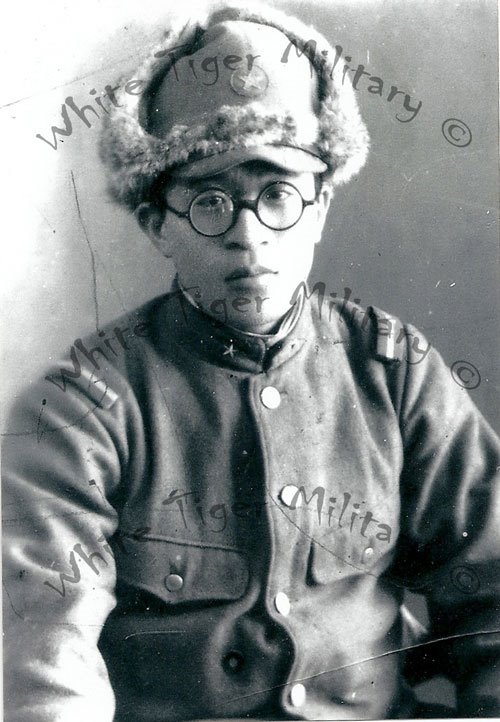
There were several variations to the design of the army winter fur hat made from 1930 through 1945. While the winter fur hat is seen as a single piece of headgear, the design was more utilitarian. The fur hat was worn as a single piece of headgear for protection against the extreme cold but it was also designed to be worn beneath the Type 90 helmet in combat. Aviators, particularly crewmen such as gunners who were exposed to wind and cold also wore the fur hat inside aircraft. Early fur hats were lined with ox or other long hair animal fur but the most common fur used after 1930 was rabbit fur. The fur hat worn in the photograph has a cloth visor on the front of the hat and many of the early army winter fur hats were made both with and without a permanent cloth visor and one variation had a small rabbit fur lined visor that folded up and down. By the mid 1930’s the visor was removed likely to reduce cost and simplify the design. For additional warmth some soldiers wore combat caps under the fur hat which exposed the visor. It is difficult to tell from the photograph exactly which type fur hat this corporal is wearing. There are two cloth chin straps sewn inside the fur hat to secure it on the head when the side flaps are buttoned up. Fur hats generally made prior to the introduction of the steel helmet had metal star insignia while most, if not all, hats made after 1930 had the two piece star cloth insignia which made the hat easier to wear under a helmet. The hat’s interior crown was lined with a piece of muslin cloth that protected the interior from dirt and skin oil and could be replaced when soiled. The army fur hat has the “koh” and “otsu” quartermasters stamps on the interior lining. Some officers had custom made fur hats but many wore the same type of hat as seen in this picture with the same insignia.
Red Cross Nurses Cap
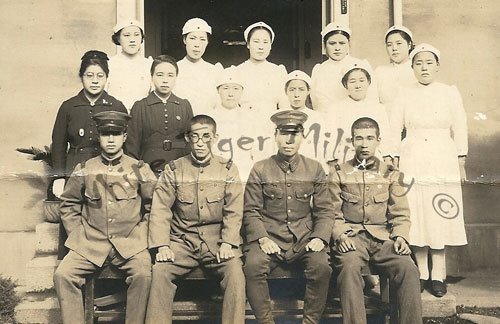
Due to a shortage of military medical personnel the army and navy employed Red Cross doctors and nurses to support the military medical corps. Female nurses were used both in Japan and overseas at military installations and hospitals. They shared in the hardships and danger of being in a combat zone along with the servicemen they treated.
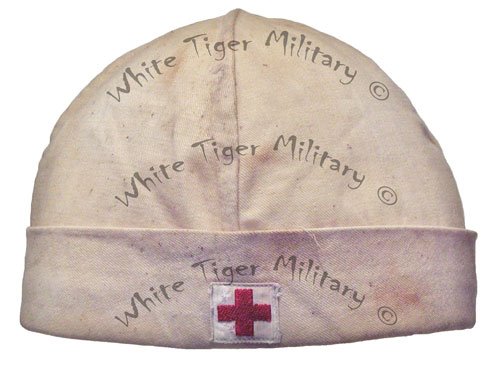
Pictured is one of several caps wore by female nurses during the Showa era. These cotton cloth caps had a simple design and were generally white in color to appear hygienic and clean. In the field, with the shortage of supplies and replacement uniforms, nurses working uniforms including caps were sometimes dyed green to cover dirt and stains and hide wear. The caps interior is unlined and while not marked they likely came in general sizes of small, medium and large. The insignia on the front of the cap may vary from a plain felt red cross to a bevo patch.
Naval “Boonie” Hat
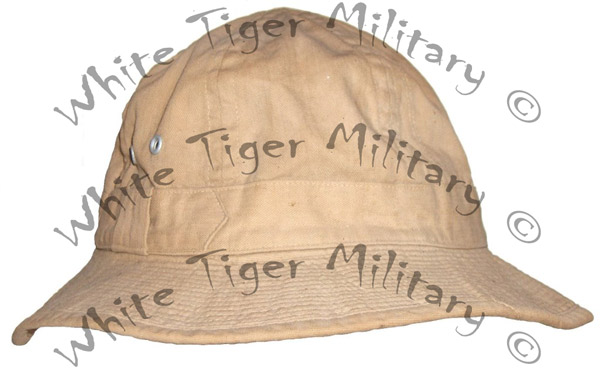
The naval hat was developed during the mid to late 1930’s as a general all-purpose work hat to be worn with the khaki shorts and shirt work uniform both aboard ship and for duties ashore. The hat was a simple substitute for a sun helmet and its khaki color cotton canvas material made it cost effective to produce, easy to clean and dried quickly when wet. There are two unpainted aluminum vent holes on each side and like other army and navy work hats it was made without an insignia or a provision for one. This hat does not have a chin strap due to its design and shape which would have made one impractical.
The unlined interior has a cloth sweat band and is made in general sizes of small, medium and large and the overall design and materials allowed it to be folded and tucked away when not in use. There is a naval quartermaster’s label sewn to the upper interior dated May of Showa 16th year (1941).
1945 Army Enlisted Combat Cap
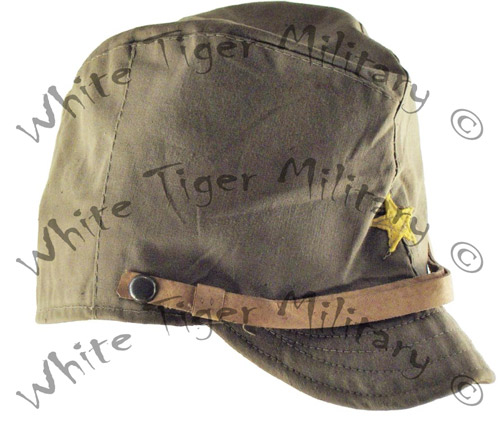
Throughout the 1940’s Japanese enlisted combat caps were subject to the same shortages of materials and substandard workmanship found in most other military uniforms and equipment of the period. Shown is an example of an army enlisted combat cap made during the 1944 – 45 period that displays some of the common features seen on late war combat caps. The cap is made from light weight green cotton cloth and at times the base material came from different dye lots that did not match in color leaving some caps with a less than uniform military appearance. As evidenced by the seam, the sides of the cap use two smaller pieces of material instead of a single piece used on early cap patterns. Side vent holes and factory sewn havelock threads were eliminated to conserve on material and reduce manufacturing time and labor. The visor may or may not have reinforced stitching across the bill and the bill’s underside is made from multiple pieces of cloth rather than a single piece. The star insignia is sewn directly to the front of the cap and may lack the circular cloth backing. The lace holes on each side of the size adjustment cut out located on the back of army combat caps have been reduced from three to two holes and the sewn reinforcement on each hole was barely enough to trim the hole adequately.
With leather in short supply or unavailable, cloth and rubber was substituted to make the chin straps and sweat bands. The adjustable chin strap lacks the metal bale wire slides and used a leather or cloth design similar to naval chin straps. Plain tin side buttons that secured the chin strap were often replaced with buttons made of wood, leather or Bakelite. Some army chin straps were sewn directly to the cap navy style without buttons. At times, interior sweat bands were pieced together from 2, 3 or 4 pieces of scrap leather or cloth.
The cap’s interior is lined with white muslin cloth which may be pieced together using as many as five smaller pieces of scrap material. The liner has the “koh” and “otsu” quartermaster’s ink stamp blocks but their placement on the liner can be in odd locations likely due to poor workmanship. The cap shown above is dated Showa 20th year (1945) and has many of the features described above. Not all late war caps are the same and differences in workmanship and materials vary from cap to cap depending upon the manufacturer and available materials which created a number of variations in combat caps during the 1940’s.
Army Arm of Service Collar Flash
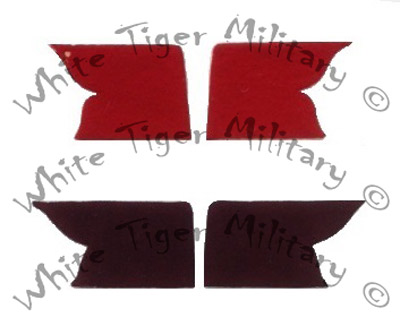
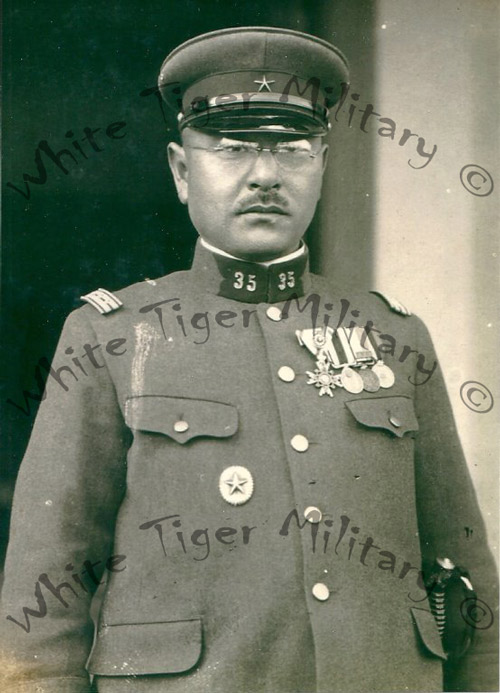
This type of insignia was worn on the collar of officers and enlisted uniform jackets by the Imperial Army through the Taisho and Showa eras until 1938. The collar patch is sometimes referred to as a “collar flash” or “corps” insignia and came in a small number of different colors that identified the wearer’s arm or corps of service. The basic flash colors were; infantry (hohei ka) and armor (sensha ka) wore red, cavalry (kihei ka) wore yellow, engineering (kohei ka) wore maroon, medical (gun-i bu) wore green, band (gungaku bu) wore dark blue, veterinary (jui bu) wore purple, military police (kempei ka) wore black and the Judge Advocate General (homu bu) wore white. With the army’s creation of additional corps and the transition to new uniform styles during the late 1930’s there is some evidence that other flash colors may have briefly existed including air corps (hiko ka) wearing light blue. Often the flash colors were not uniform and their color was only as good as what the maker could supply. Each flash may vary slightly in color depending upon quality of dyes and the materials and their exposure to the elements which can sometimes leads to a misidentification of the patch. The flash was also worn with a variety of small metal insignia and Arabic and Roman numerals that were either sewn or pinned to the flash. The combination of the symbols and numbers further identified the wearer’s regiment. The flash itself was tack sewn to the uniform and could be easily removed if necessary.
By 1938 the continuing war in China brought about major design changes to army uniforms and insignia which resulted in a redesign of the tunic. Arm of service flashes were eliminated and replaced with a smaller sewn-on cloth “M”or “zig-zag” insignia that required less material to make. Many of the symbols and numbers continued to be worn on the jacket collar even after the cloth flash was officially eliminated. Eventually almost all arm of service insignia was eliminated from the uniform during the war for security reasons.
Japanese “yoshigaki hinomaru” Flags
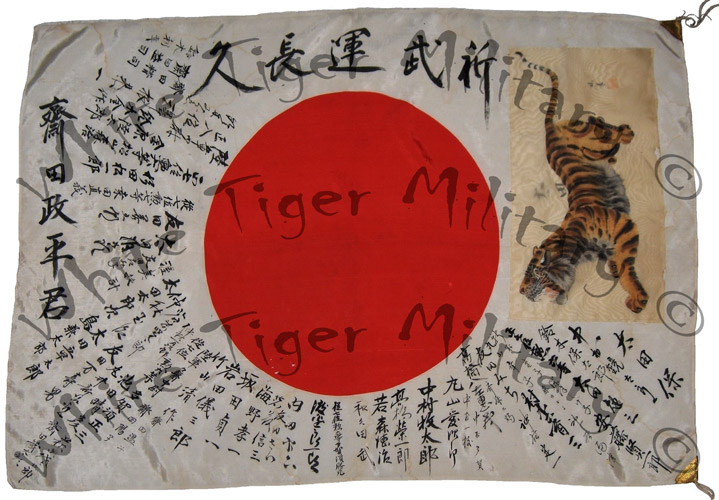
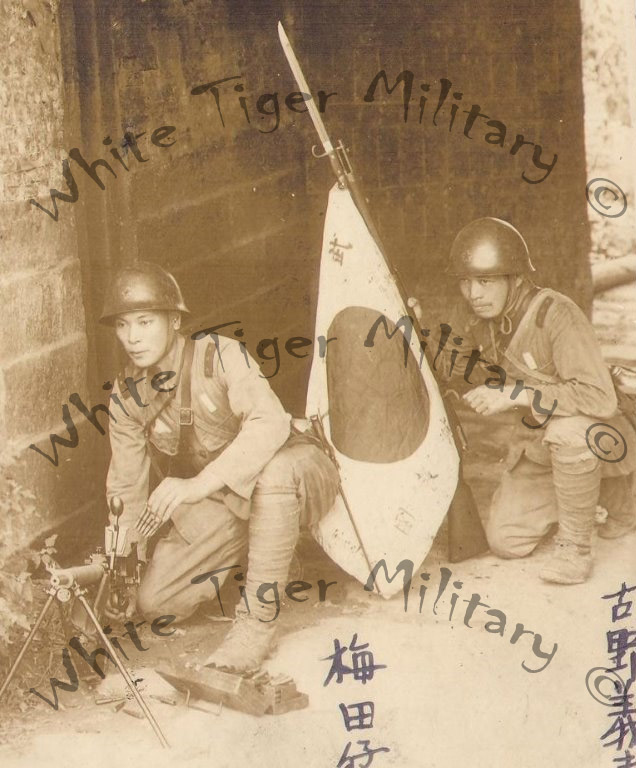
Photograph courtesy of Dr. Michael Bortner.
One of the most iconic souvenirs brought home by many American servicemen who fought in the Pacific theater were the personal flags carried by nearly every Japanese soldier and sailor including officers called “yoshigaki hinomaru”. For young Japanese men inducted into the military, a plain national flag was purchased or sometimes hand made by a family member and using a brush and ink their classmates, co-workers and family wrote their names and good luck wishes on the front of the flags. Children and adults who couldn’t write, might leave their handprint in ink on the flag as a reminder. Symbolic artwork depicting tigers, dragons, gourds and landscapes were used to decorate flags. In addition, some flags were blessed and stamped with a temple seal in order to further protect a soldier from harm. Some flags were marked with an oath, written on the flag with the owner’s blood or that of a friend. These blood oath flags pledged the soldiers greatest determination to fight and die with honor. Period photographs often show soldiers proudly posing with their flags. Good luck flags were often taken into battle, tied to a rifle or tucked inside a uniform as a constant reminder of home and family. "Yoshigaki hinomaru", brought back from the war, are sometimes found with battle damage or stained with the blood of those who carried them. Each flag is unique and as a piece of art, stands alone in their composition and beauty. As historic items, they are grim reminders of war’s ultimate cost. More information about “yoshigaki hinomaru” flags, “senninbari” (one-thousand stitch belts), and good luck charms can be found in Dr. Michael Bortner’s book “Imperial Japanese Good Luck Flags and One Thousand Stitch Belts” which is listed in the Recommended Publications section of this site.
Captured British Mark II Helmet
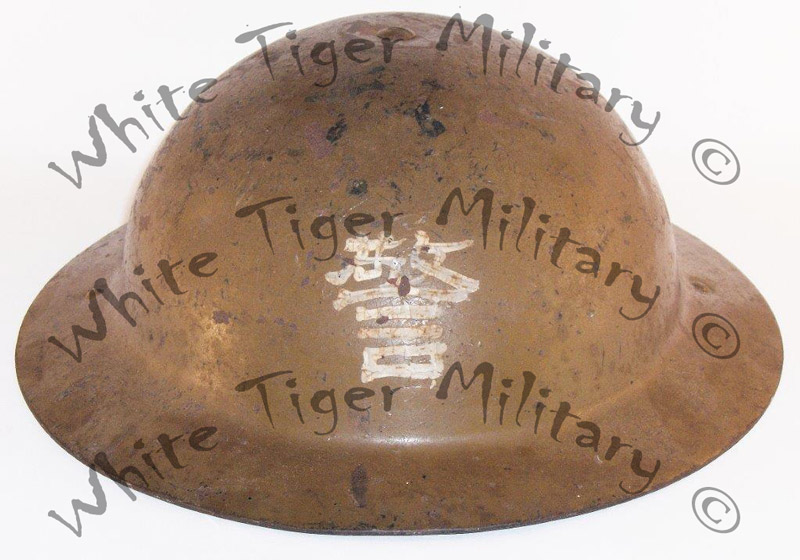
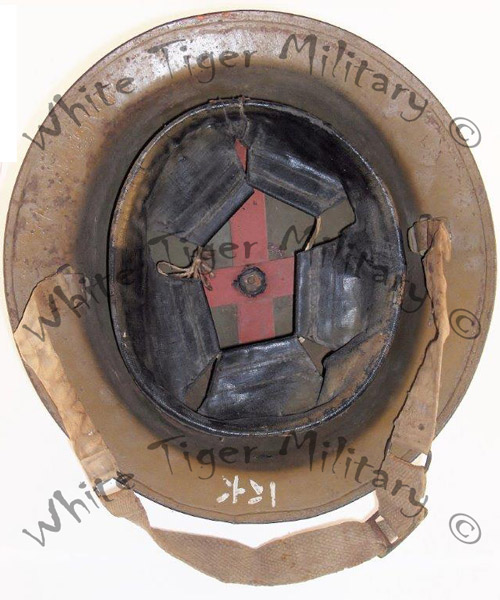
During the early stages of the war as the Japanese advanced across the Pacific, there were acute shortages of supplies and equipment including military helmets with each service branch. As the Japanese captured more territory they would make use and take full advantage of the equipment and supplies that fell into their hands. Among the items were captured enemy helmets, which were sometimes pressed in to service by the Japanese to supplement the shortages of Type 90 helmets for their own troops. This complete captured British Mark II helmet has been repainted using Japanese military brown paint on the exterior and interior flange leaving the helmet’s original color on the interior crown. A large kanji character which translates into “security” has been painted in white on the exterior front of the helmet. The outline of the stenciled painted name of the helmet’s former owner can be seen on the interior upper left side rim and a three digit identification number (186) in kanji has been hand painted on the lower right side rear of the interior rim. Several of these helmets both with and without liners have been seen and are all painted in the same similar fashion with numbers that are fairly close indicating they came from the same area. One helmet shell a different kanji character painted and covered over on the front of the helmet, indicating the helmet had several different uses by the Japanese. These helmets are reported to have been worn by Japanese naval installation security personnel in rear echelon areas.
Army Nautical Force Enlisted Cap
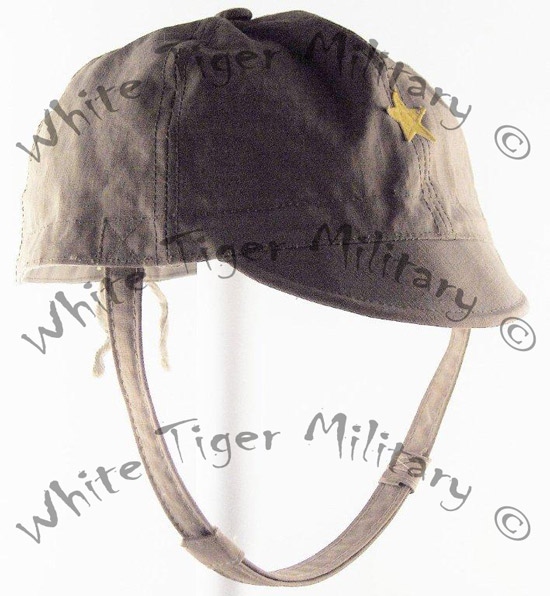
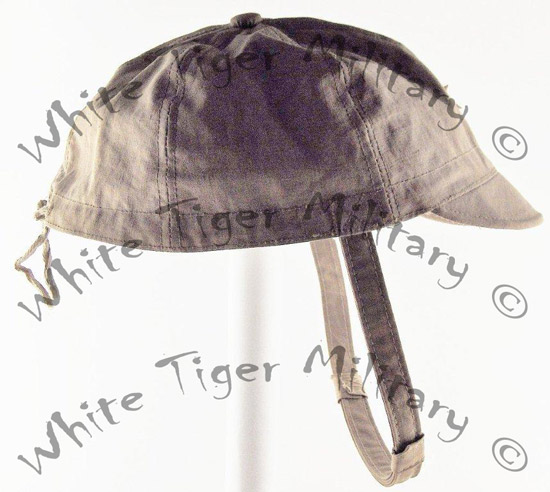
One of the lesser known caps worn by the Japanese army during the war was nautical force cap, specifically designed for soldiers assigned as crewmen aboard army landing craft, boats and ships. The cap’s “bennie” style design is similar to the army’s exercise cap, having an adjustable chin strap that is sewn permanently in the down position to prevent the cap from being blown from the head in windy conditions experienced aboard ship. The cap is constructed of unlined green cotton cloth which allows it to dry quickly when damp. Most of these caps have a single quartermaster’s ink stamp on the interior with the year of manufacturer. The same yellow one piece cloth star insignia on the front of the cap was worn by all ranks. Enlisted caps were plain while caps worn by NCO’s and officers had colored stripes sewn around the exterior body that identified the rank of the wearer similar to the system worn on naval combat caps. NCO caps had a single black stripe while officer’s caps had two white strips. For collectors, enlisted caps can be found, but examples of NCO and officer’s caps are rare and very difficult to find.
Army Aviation Training Helmet
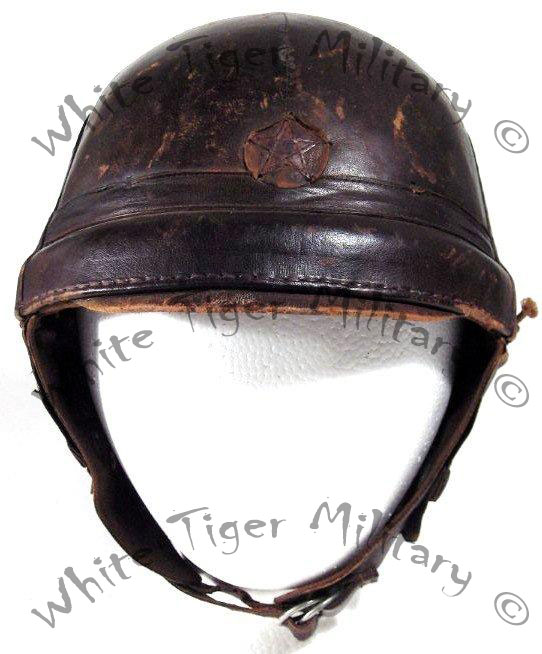
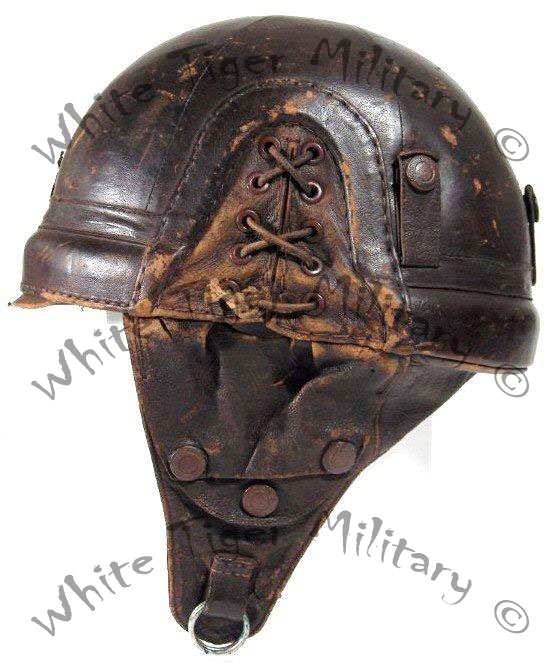
During their early training Japanese army aviation cadets began wore a specially made training helmet for additional protection in case of an accident. These helmets have no ballistic properties and were designed to provide impact protection and insulation against the elements encountered in an open aircraft. The helmet’s overall design appears to be a throwback to earlier flight helmets worn during the post World War I era and shares a similar appearance to the army’s winter tank helmet with the most obvious difference being a small leather visor under the front edge of the flight helmet. The helmet’s woven natural material shell with additional padding is covered in leather and has a two piece leather star sewn on a leather circular backer on the front of the helmet. With no visible size markings this helmet probably came in one size only with minor adjustments to the size made using the laces on the exterior side cutouts. There are three leather goggle retaining straps with snaps located on the exterior sides and rear of the helmet. A leather cape extends down from the upper shell to cover the sides of the face and back of the neck and is equipped with the standard double “D” rings and chin straps closure system that is used on most army helmets of similar design. There are ear flaps with multiple metal snaps that allow the trainee to wear earphones underneath the helmet for communication with the flight instructor. The helmet’s interior is completely lined in leather with additional padding sewn around the interior edge. It does not appear that the Japanese navy had an equivalent helmet for their aviation cadets.
First Variation “Star-Vented” Naval Helmet with Insignia
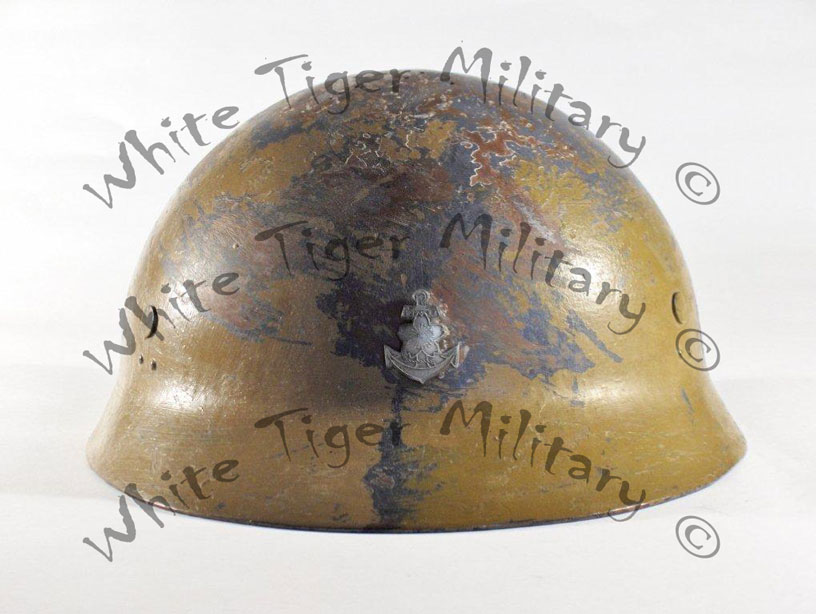
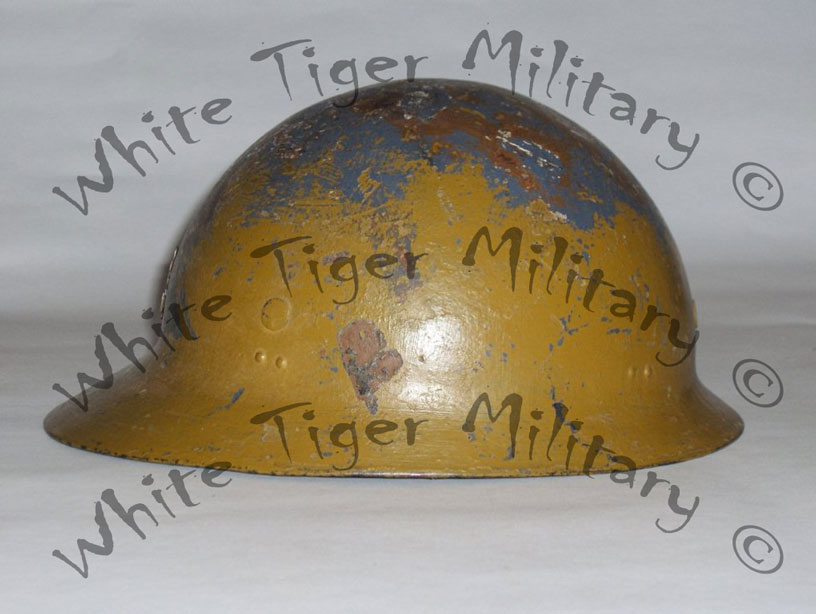
This helmet was one of several variations of the early M-18, and with no number designation and little available information for many of these helmets there has been some confusion as to their official identification. To add to the confusion, the navy often referred to M-18 brimmed helmets as the Model 2 to differentiate them from other helmets worn by naval forces during the 1920’s.
The helmet most prominent feature was the extended front visor and even though it was found to be problematic it continued to be a permanent part of the design. Some of the design elements incorporated in this helmet remained in use in future helmet variations including the Type 90 helmet. The introduction of the star vented helmet came in 1922 and was made without an insignia. Field testing exposed several flaws in the design, the most immediate of which was the helmets reported poor ballistic qualities. This produced led to the next variation, the star vented helmet with an insignia. This variation came with an enhanced steel shell and the addition of a permanent insignia.
The shell had a rolled edge with 15 small ventilation holes forming the shape of a star on the helmet’s crown. There are three liner pin slots through the shell, one on each side of the helmet’s front and one in the back and with the addition of the insignia the liner had four points of support. Arsenal and inspection markings can be found stamped into the underside of the interior front brim but can be overlooked due to their location, small size or are obscured by layers of paint. This helmet introduced the use of a permanent insignia which eventually became a functional part of the helmet and were incorporated on most military helmets throughout the rest of the war. As an insignia the navy selected a rope fouled anchor and cherry blossom design made of nickel silver. The insignia required a fourth slot through the helmet’s shell which impacted the strength of the shell. Initially, the insignia’s prongs only held it in place. In later variations, the insignia’s prongs were used as a fourth point of support for the helmet liner which required an additional slot through the liner band to accommodate the prongs. Initially naval helmets were painted gunmetal blue/grey but as the navy became more involved in land operations during the Manchuria and China campaigns, the blue/grey color was given an overcoat of mustard brown paint for camouflage purposes which sometimes covered the insignia.
This helmet and all of the variations used the same interior three pad leather liners and cloth “Y” shaped chin strap configuration. The liners were undated and without a size marking indicating the helmets and liners may have been made in only one size. Some liners have a single kanji character stamped on the liner band but the meaning of the character is not fully understood. While these liners and the Type 90 liners are similar in design they were not interchangeable due to the larger size and shape of each of the star vent liner pads and the different locations of the liner pin and chin strap support slots. The three pads were sewn to a liner band consisting of two semi-circular pieces of leather that are held together at a front and rear joint with six stitches in each joint. The liner band is held in the helmet by the three liner pins and the insignia. The chin strap system was formed by two 38“ pieces of cloth strap, each threaded through two “D” rings riveted on the interior sides of the shell’s flange. The top end was folded and sewn together forming the straps distinctive “Y” shape. The strap ends were folded and sewn finished preventing fraying. This same “Y” pattern chin strap design would later be resurrected and adapted for use in naval paratrooper helmets. As the Japanese continued to engineer the design of this helmet, the star vent on the helmet’s crown was replaced with a single vent hole covered by a steel cherry blossom around 1926, dramatically affecting the helmet’s appearance giving the new helmet its signature name, the “cherry blossom” helmet. Due to the shortage of helmets, the star vented and cherry blossom helmets continued in use into the mid 1930’s.
Second Model Naval Mechanics Cap
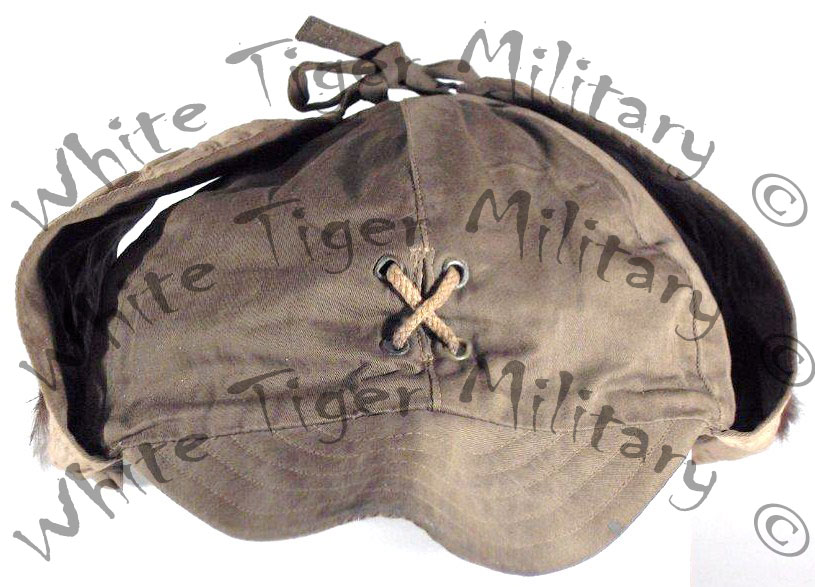
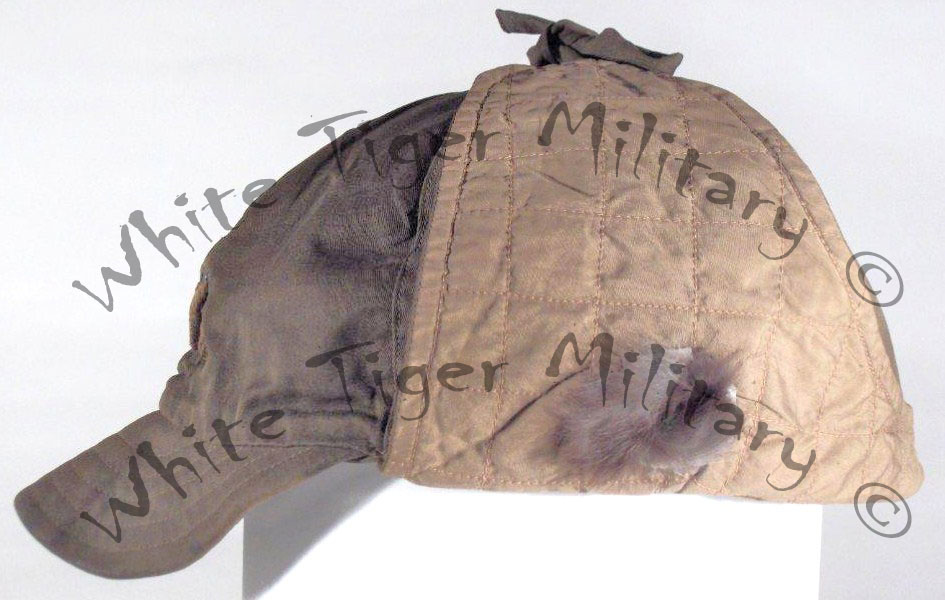
The naval mechanics cap was introduced in 1936 with a similar design to the army’s mechanics cap. The original cap was made in two distinct models; the first model was intended for land based mechanics was unlined and made using green cotton canvas. The second model cap was made for flight engineers using flight suit material insulated with rabbit fur. Depending upon the manufacturer, the second model varied in the quality of the material, construction and the amount of rabbit fur insulation in the interior lining. The cap has a large reinforced bill and side ear flaps that can be worn either tied over the top of the cap or lowered and tied under the chin to secure the cap on the head. The ear flaps have ear holes on each flap with the first model having five small sewn reinforced ear holes on each flap and the second model having only a single large hole on the ear flaps. These caps were made without insignia and did not have rank stripes sewn around the cap to identify the wearer’s rank. There are four metal eyelets on the front of the cap with a lace running through the holes forming an “X” directly over a one inch slit in the cap’s center seam. This hole allows the mechanic’s flash light wire attached to the battery case to be threaded through a one inch horizontal buttonhole on the interior left side of the cloth sweat band. The wire runs behind the sweat band and out through the slit in the front of the cap where the light was clipped to the cords on the front of the cap. This allowed a mechanic to work hands free in a confined space such as an engine compartment or aircraft’s interior with illumination and the wire tucked out of the way. These caps have a naval quartermaster’s cloth label sewn to the interior lining. The size markings indicate the caps were made in a number of different sizes other than small, medium and large. With the introduction of the combat cap the production of the mechanics caps ceased around 1939 probably due to their high cost of construction. The cap received a short reprieve when some naval paratroopers began to wear them under their jump helmets during training. Following the navy’s decision to abandon the para program in 1941 these caps disappeared completely.
Army Experimental Felt Combat Cap
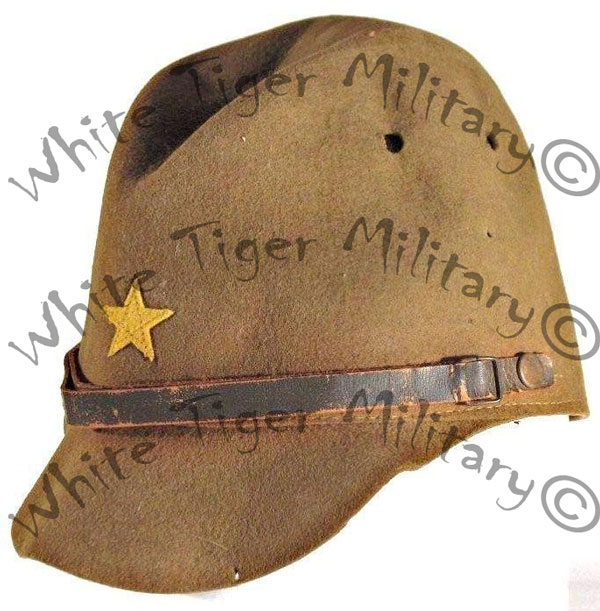
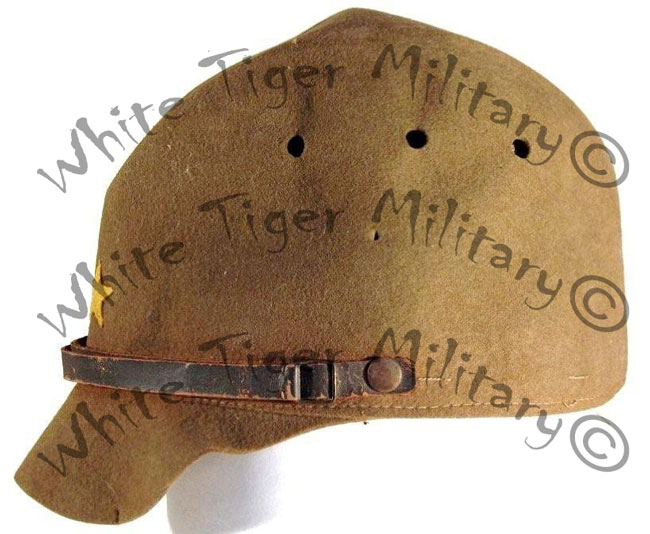
The experimental felt combat cap first appeared in 1937 and was field tested by the army over the next several years. The felt cap was worn by enlisted and officers but it is not clear if the officer’s cap was made with higher quality internal materials or custom features. The material of the felt cap ranged in color from yellow-brown to green. The felt cap was made in two variations, the first was steamed and blocked from a single piece of brown felt and had a separate felt bill without reinforced stitching sewn to the cap’s body. A later variation of this cap was a one piece construction with the entire cap steamed and blocked from a single piece of material. The felt material and the labor intensive blocking process gave this cap a distinct shape which made it difficult to wear under a helmet. The felt cap used a one piece yellow cloth star insignia sewn directly on the front of the cap. The vent holes on these caps consisted of three unreinforced holes punched through the sides of the cap. The adjustable multi piece leather chin strap had bale wire slides of the same design worn on other combat caps. Variations of this cap’s chin straps made in the late 1930’s supplemented lower grades of leather or flax leather. Enlisted caps used plain flat metal side buttons with prongs that were pushed through the sides of the cap and had the prongs bent over a metal washer to reinforce the hold on the side button. There is no size adjustment cut out on the rear of the felt cap to make minor adjustments to the cap’s size, which indicates this cap had to be made in a greater number of sizes then small, medium and large. The cap had a one piece leather sweat band stitched around the interior of the cap and a muslin cloth liner stamped with the two quartermaster’s blocks. The felt combat cap had a detachable neck shade made using a difference design than those used on later model combat caps. The neck shade had five cloth panels with five metal hooks to attach and suspend the shade from five threads sewn around the back half of the cap. Without the size adjustment cut out on the back of the cap there was no provision to tie the neck shade securely to the cap. A major drawback to this cap was the use of felt which was very susceptible to insect damage. Beginning in 1939 the felt combat cap was gradually phased out of service but continued being worn into the 1940’s until the supply of caps was exhausted. There is no indication that the navy experimented with a cap made with this design or type of material.
Army Rigid Shell Winter Tank Helmet
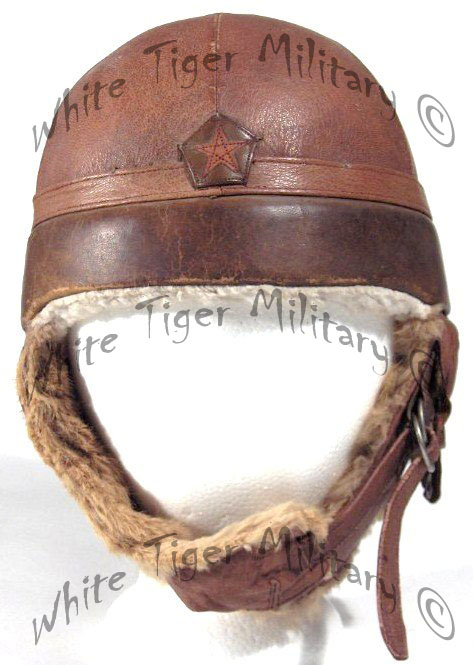
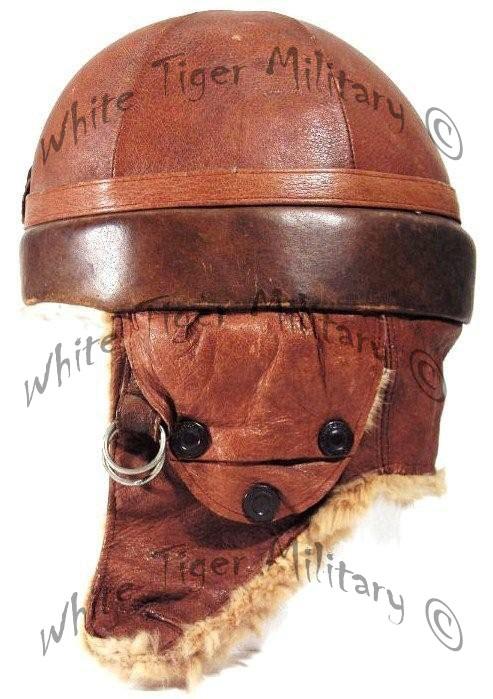
This helmet model was introduced in December 1936 with an exterior design similar to the earlier soft model helmet. The exterior is covered in cowhide over some sponge rubber padding and the chin strap has a preformed sewn-in cup with a double “D” ring closure. Like most army headgear, there is a leather star on a pentagon shape leather backing sewn to the front of the helmet. The helmet’s exterior does not have any goggle retaining straps. Two multi snap ear covers are on the sides of the helmet that allow for the placement of headphones. The helmet’s interior shell is made of natural reed materials which provides some insulation against the cold but mainly is designed as protection against impact. The helmet is without any ballistic qualities and offers no protection against enemy fire. The interior is lined in rabbit fur and cloth with faux fur replacing the rabbit fur in some helmets. There is a Showa date type ink stamping similar to those used in steel helmets on the interior lining which many times is unreadable due to the loose weave of the interior material. These helmets were made in small and large sizes only and have a suspension system with a draw string that allows for some adjustment to the interior sizing. This design was revised in October 1942 which was likely to allow the use of some alternative materials due to war time shortages.
Naval Souvenir Cap Ribbons

During the 1920’s and 30’s, future Japanese naval officers trained on older warships with a cruise to foreign ports particularly those on the west coast of the U.S. The navy produced same size reproductions of the sailor’s flat hat ribbons to be presented as gifts to guests who were received aboard ship. These ribbons were similar to the ribbons worn by enlisted sailors who were assigned to these ships. The hat ribbons bear the individual ship’s names and anchors in gold leaf gilding but the souvenir ribbons were printed on green, orange, red, purple and dark blue silk. It is likely that the number of ship names used on these souvenir ribbons was limited to the few training ships assigned to this type of duty. With the escalation of the conflict in China during the mid to late 1930’s the number of Japanese warships allowed to visit US ports was likely reduced or restricted which would have ended the practice of making and presenting souvenir hat ribbons.
Army Sun Helmet 1
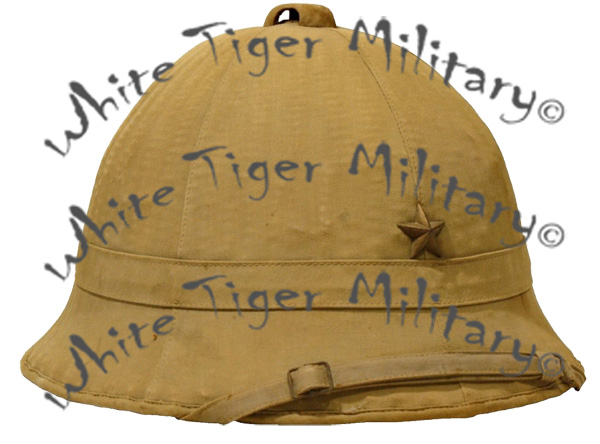
Army Sun Helmet 2
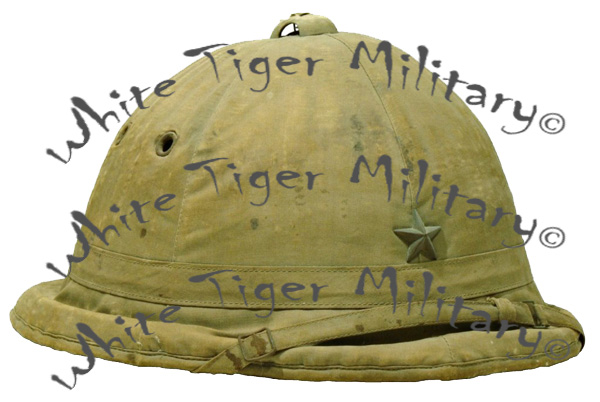
One of the many different sun helmet designs worn by the Imperial army during the late 1930’s and into the 1940’s was this model made of woven rattan. The exterior is covered with tan to green cotton cloth with some helmets having a thin layer of padding of the same material type found inside a helmet cover between the rattan shell and the covering. This padding was eliminated on some later variations of this helmet. Of the examples of this model sun helmet, all have a metal star insignia but it seems likely that other insignia may have also been used. The helmet has an adjustable cloth chin strap suspended from the interior. This helmet was made in several variations and combinations with or without a top knob and with and without side vent holes and with and without both. When present, the top knob covers a large metal reinforced vent hole and the side vent holes are reinforced with large metal grommets. The helmets interior may be lined with green cotton cloth or be unlined exposing the rattan shell. Depending upon the availability of materials, various sizes of rattan were used to make the helmet shell. The rattan shell is fragile and breaks down very easily around the lower flange area. This helmet cannot be folded like some other sun helmets without destroying the shell. Standard “koh” and “otsu” army QM cloth tags were sewn to the interior rattan shell or to the cloth lining. The interior suspension system allows the helmet to be worn as a separate piece of headgear or can be untied allowing the helmet to fit over a Type 90 helmet. While many officers wore custom sun helmets, this helmet was worn by officers and enlisted alike.
Navy Flight Helmet
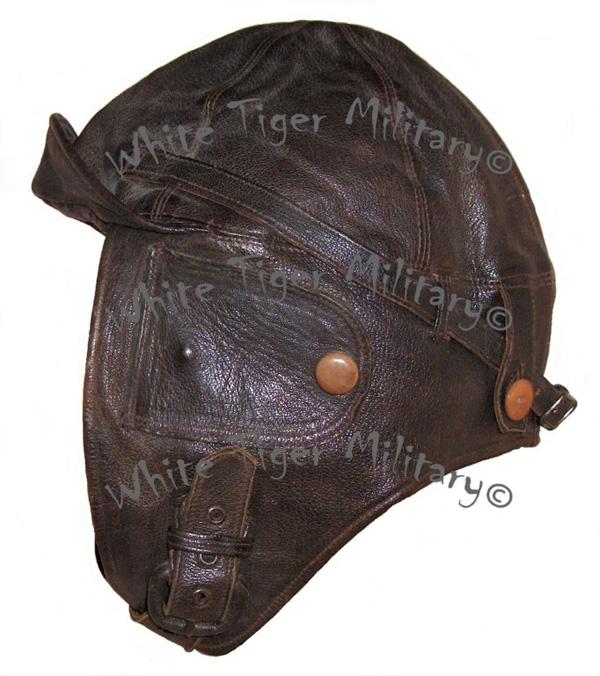
During the early 1930’s, the Japanese navy created a basic flight helmet design with a vastly different appearance from the army flight helmet. This 1st model naval flight helmets distinctive appearance made it very popular among naval airmen with soft leather ear coverings that allowed the sides to be folded up over the top of the helmet and worn like a cap even when the airman was not in an aircraft. The helmet color ranged from black to various shades of brown and camel although dark brown was the most common color. Naval flight helmets had a flip down leather visor with a snap closure on the front of the helmet which eliminated the space for an insignia even on custom helmets made without a visor. This helmet has an adjustable leather size strap around the exterior crown of the helmet and there is a green cloth tag sewn between the two goggles retaining straps on the back of the helmet for an owner’s name. Navy flight helmets had leather chin straps with a roller buckle to secure the helmet on the head. Many custom and early helmets metal buckle parts were often covered with leather. Individual helmets were different and they can be lined with colored cloth, velour or rabbit fur and may have either a private makers label or a naval quartermasters label or both sewn to the interior lining. Some custom helmets may have neither label but could have a custom embroidered name tag. Generic helmets were made in small, medium and large sizes with the size written on the quartermasters tag. Many airmen purchased their own flight helmets, goggles, gloves, and boots that were custom styled and fit for the buyer. Dependent upon the airmen’s preference, custom features such as the visor, size adjustment strap, or a number of different styles of ear covers were either added or eliminate. Even after the introduction of the later model naval flight helmets, this style continued to be service issued or custom made for naval airmen well into the 1940’s. Mick Plodger’s book “Vintage Flying Helmets – Aviation Headgear Before The Jet Age” is a good resource for pictures of other Japanese flight helmets and goggles of the period.
Type 90 "Banded" Helmet Cover
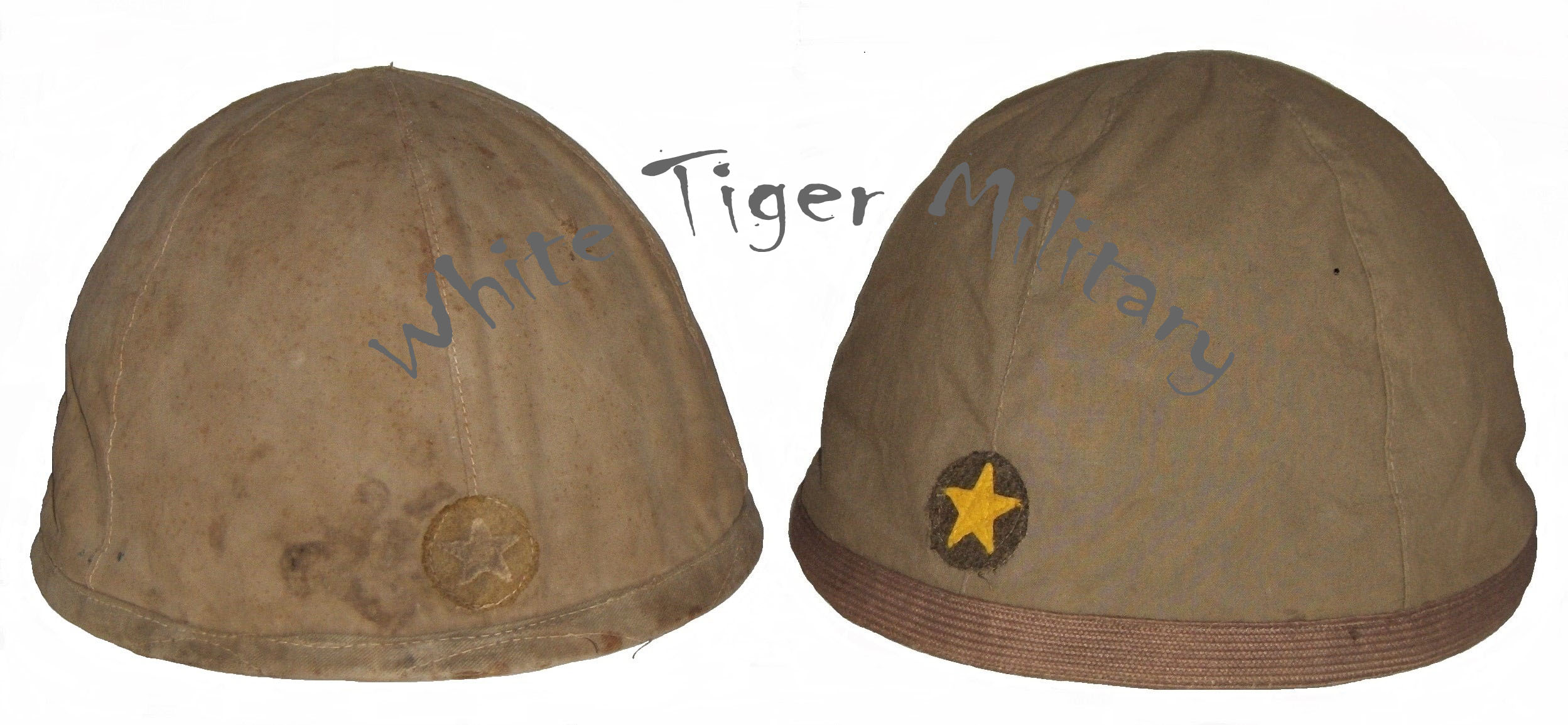
A cover for the Type 90 helmet was officially accepted into service in June of 1935, however, harsh conditions in the field quickly expose a flaw in the cover’s design. The area where the cover’s lower edge extends over the helmet’s flange quickly deteriorated with repeated contact with hard or rough surfaces. Soldiers in the field repaired the worn areas of their covers by sewing a cloth patch or with additional stitching around the edge of the helmet cover. (see 1939 dated example cover above left) The Type 90 army cover was modified on December 5, 1942, by re-enforcing the cover’s lower edge with a “protective band” of standard chin strap material sewn around the edge of the cover. (see 1943 dated cover above right) This simple modification reduced wear to the affected area and prolonged the serviceable life of the cover. Protective bands were never implemented on naval helmet covers but examples of field repairs and field applied protective bands are commonly found on both army and navy helmet covers. Even though the army discontinued the production of small size helmets at about the same time the banded cover was introduced, the new Type 90 “banded” cover continued to be produced in both large and small sizes. The “banded” helmet covers continued to display both a one and two piece cloth insignia and with the machine embroidered pentagon shape star insignia during the latter stages of the war. This cover should always have the army ink stampings that include the “koh”(official) and “otsu” (user) block stamps along with the manufactures and model stamps on the interior lining.
Type I Naval Enlisted Combat Cap
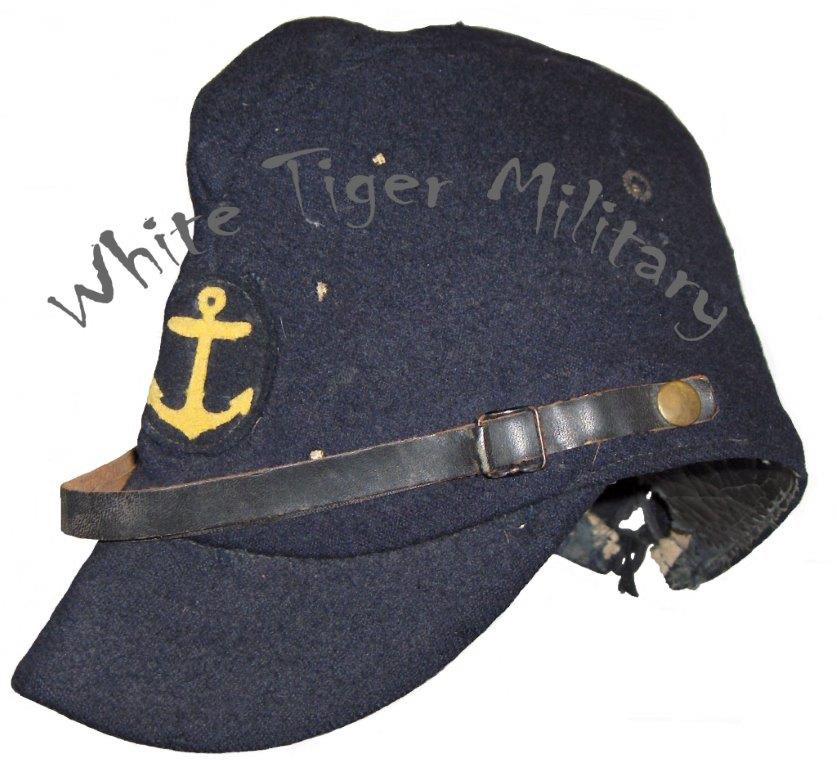
A first model naval enlisted men’s combat appeared in 1935-36 and was an all purpose cap worn in place of the service hat and during shore operations. Often called “combat caps” these caps could be easily folded and tucked away when the sailor was wearing a helmet or worn under the helmet for additional warmth or padding. This cap was designed to be worn with the Type I uniform had a simple design and were relatively easy to manufacturer. The first model Type I cap is made of dark blue wool and features a two piece plain yellow wool/felt anchor hand tacked to a wool oval. The same two piece insignia found on the early model caps was an emblem of service worn by both enlisted and officers. This insignia was labor intensive to produce and by the late 1930’s the two piece insignia was replaced with a bevo anchor insignia on most naval combat caps. The enlisted cap has a plain adjustable black leather chin strap with bale wire slides and plain brass side buttons. This cap has two sewn reinforced vent holes on the sides although some caps had three vent holes on each side which likely varied from manufacturer to manufacturer. Like most navy caps there is a size adjustment cut out on the back of the cap with two tie string holes on each side of the cut out. Like other navy caps this area is reinforced with a line of stitching. This cap has an interior leather sweat band and is lined with white cotton cloth that is only tack sewn into the cap for easy replacement when it became damaged or soiled. A cloth naval quartermasters tag is sewn on the right side of the cap’s liner but this location allowed contact with the head and become dirty with sweat and head oils. On later made caps the tag was moved to the interior crown. The early officers Type I caps were very similar in appearance but were made with higher quality cloth and leather materials and custom name labels. A two piece anchor and cherry insignia replaced the simple anchor patch on officer’s caps to further identify officers from enlisted men. The Type I cap was a work horse uniform and cap for the navy for a short period but the introduction of the Type III (green) uniform and cap eventually replaced most of the other naval uniforms. By the mid 1940’s many naval personnel were issued only a Type III uniform and cap due to shortages.
Naval “Shanghai” Helmet
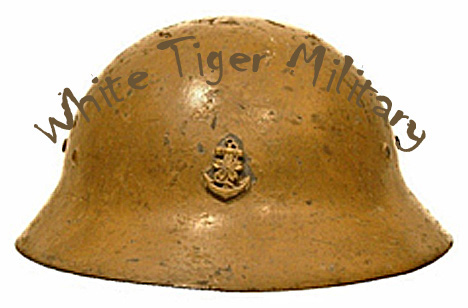
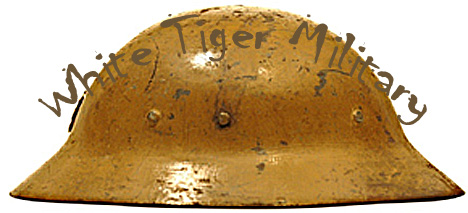
This extremely rare helmet was made in relatively small numbers and was worn exclusively by naval landing forces operating in Shanghai, China during the late 1920’s and early 1930’s. This helmet does not appear to have been an experimental design but rather a temporary solution for the shortage of combat helmets for naval forces. Without an official designation the navy sometimes referred to this helmet as the Model 1 to differentiate it from other helmets worn by the navy. Unlike other Japanese helmets of the period, it had a more complex design with a larger number of parts and materials. Originally the shell did not have an insignia but a variety of different naval insignia were worn on this helmet at different periods. Its oblong shape appears very large measuring 12 ½” from front to back and 10” from side to side. These helmets were initially painted gun-metal blue grey on both the interior and exterior but as the navy’s participation in shore operations in China escalated the exterior shell was given a coat of mustard brown paint for camouflage. The multiple layers of paint on the very few remaining examples of these helmets hide any evidence of manufacturers or size markings so that any indication of where or by whom these helmets were produced remains unclear but it appears likely it was made in Japan rather than China.
TYPE 45 ARMY ENLISTED SERVICE HAT
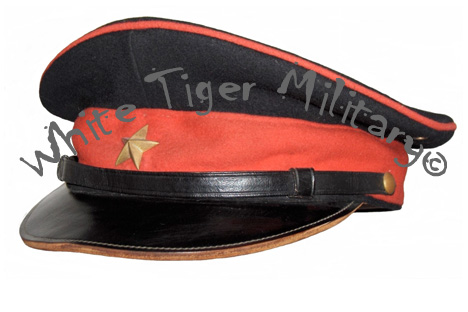
This service hat was the main piece of headgear worn by soldiers and sailors until the beginning of the 1930’s and the introduction of the steel helmet and the combat cap. The service hat was worn both on the battlefield and in garrison but they provided little to no protection against the elements or enemy fire. These hats were fitted with removable cloth covers to protect them from rain and dirt during everyday wear. This hat is a Type 45 enlisted service hat dated Taisho 10 year (1921). They were worn by officers and enlisted alike although the officer version would have been made with higher quality materials and finer workmanship. Leather chin straps with plain brass side buttons were functional piece of the hat and were often used in the field and during dress occasions in garrison. Service hats were made in multiple sizes as there was no provision for making minor adjustment to their size. Steel helmets began replacing service hats on the battlefield during the late 1920’s and by the mid 1930’s the combat cap would make the service hat practically obsolete.

